Trump tech tariffs could slam your wallet, bigly

 Image: Pexels
Image: PexelsThe Trump administration will arrive in Washington this coming January with an enormous question mark over its head: Will Trump deliver on his promise to impose tariffs of up to 60 percent, and how will that affect the technology products that Americans buy?
The short answer? No one really knows. For now, however, we have to take Trump’s words at face value, even if Trump eventually changes his mind. And if we do that, we can point you to where you’ll be paying more.
Specifically, Trump’s statements indicate that two tariffs would be imposed: a flat tariff of about 10 percent on all imports, plus an additional 60 percent tariff on goods imported from China. The Consumer Technology Association has estimated that, based on current levels and patterns of trade, the effective tariff on Chinese goods will go up as high as 80.6 percent.
Major consumer organizations, though, have begun calculating what these tariffs will cost American consumers. Prior to the election, the Consumer Technology Association said that the tariffs would raise laptop and tablet prices by 46 percent. On Nov. 4, the National Retail Federation (NRF) estimated that prices on “household appliances” would rise by 19 to 31 percent, and the price of toys would rise between 36 and 56 percent. The Center for American Progress (CAP) calculates that the average American family will pay up to $3,900 more per year, across the board, under the plan.
Though Congress has the power to impose tariffs, it can cede the power to the President. Trump used Section 301 of the Trade Act during his first term, when he levied a smaller “retaliatory” tariff against Chinese imports (specifically solar panels, steel, and consumer goods), which the Tax Foundation considered to be a $80 billion tax hike on the American taxpayer, according to the Tax Foundation. However, President Biden left virtually all of those tariffs in place, the organization found.
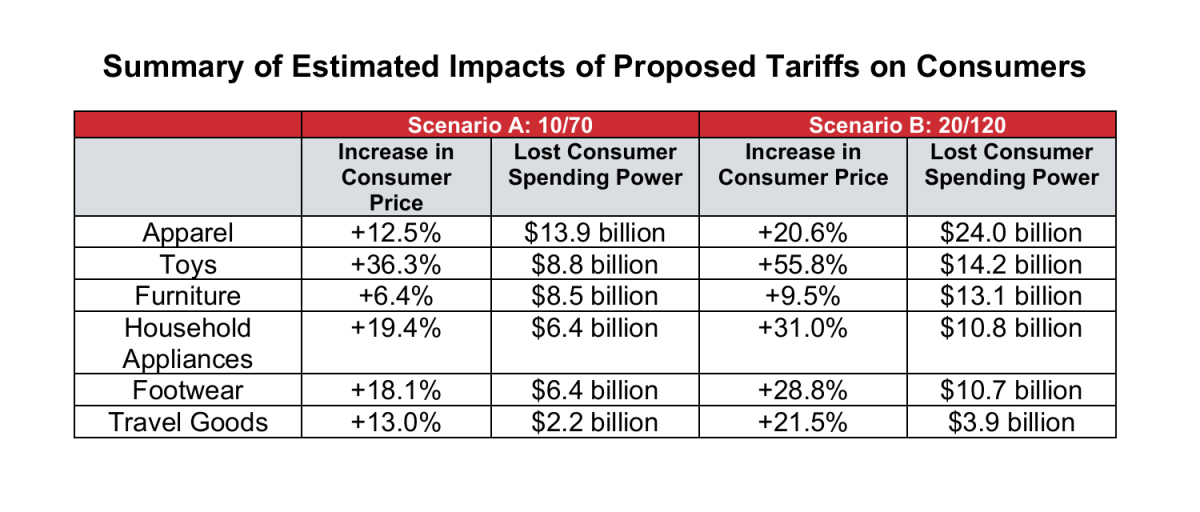
What is a tariff?
A tariff is a fee imposed by a government to import goods. Economically, it’s a lever that a government can pull to push its citizens into buying more domestically. It works most effectively, however, when the countries in question both produce a common good, such as wheat. If a country like China manufactures a television or motherboard that an American citizen can’t buy from an American manufacturer, the American buyer has no choice; they must pay the tariff regardless.
Here’s the way a tariff works: A tariff is a fee imposed at the point of entry. If a retailer wants to import a Chinese-made Blu-ray player, that retailer will buy the player for a certain cost — say, $100.
At U.S. customs, the tariff is imposed: If the retailer wants to import that player, it must pay (in this case) 60 percent of the cost, or $60. (Foreign shippers, such as a Chinese company, do not pay the tariffs.) The retailer is going to resell the Blu-ray player for a markup, anyway — let’s assume 30 percent. If there was no tariff, the consumer would pay $100+ 30 percent, or $130, for the right to run down to Best Buy or Target and pick up the player.
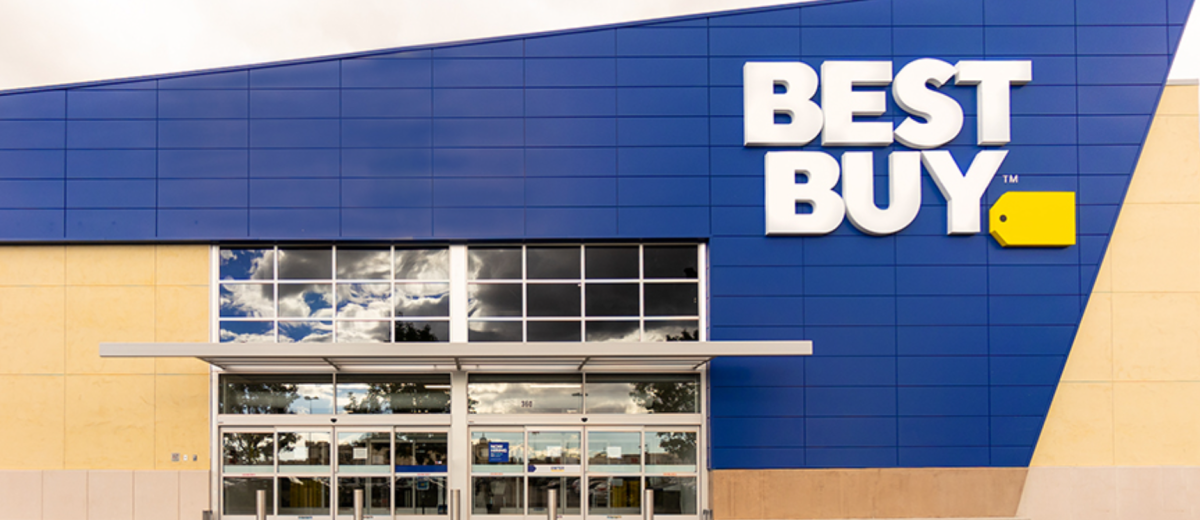
Best Buy
With the tariff, the retailer has to make a choice: Absorb the cost of the tariff and sell the player at or near the original price of $130, or pass along the tariff’s cost to the consumer. Given that a retailer has an obligation to make money, the common belief is that the retailer would opt for the latter choice and make the consumer pay. Now, our hypothetical Blu-ray player costs $100 plus the tariff’s 60 percent ($160), plus the 30 percent retailer markup: $208. That’s a difference of $78 from the original, pre-tariff price to the higher, post-tariff price.
“In brief, we find that the additional costs associated with these proposed tariffs would be too large for U.S. retailers to absorb and, when passed on to consumers, would result in prices higher than many consumers would be willing or able to pay,” the NRF said. “Some consumers would stop purchasing the items and demand would fall.”
Whether you characterize the tariff as an effective tax, as CAP does, or simply inflationary, the simple answer is that the Trump tariffs will likely raise prices.
What will Trump’s tariffs do to the price of tech products?
That’s the simple math. The problem is that electronics manufacturing is anything but simple.
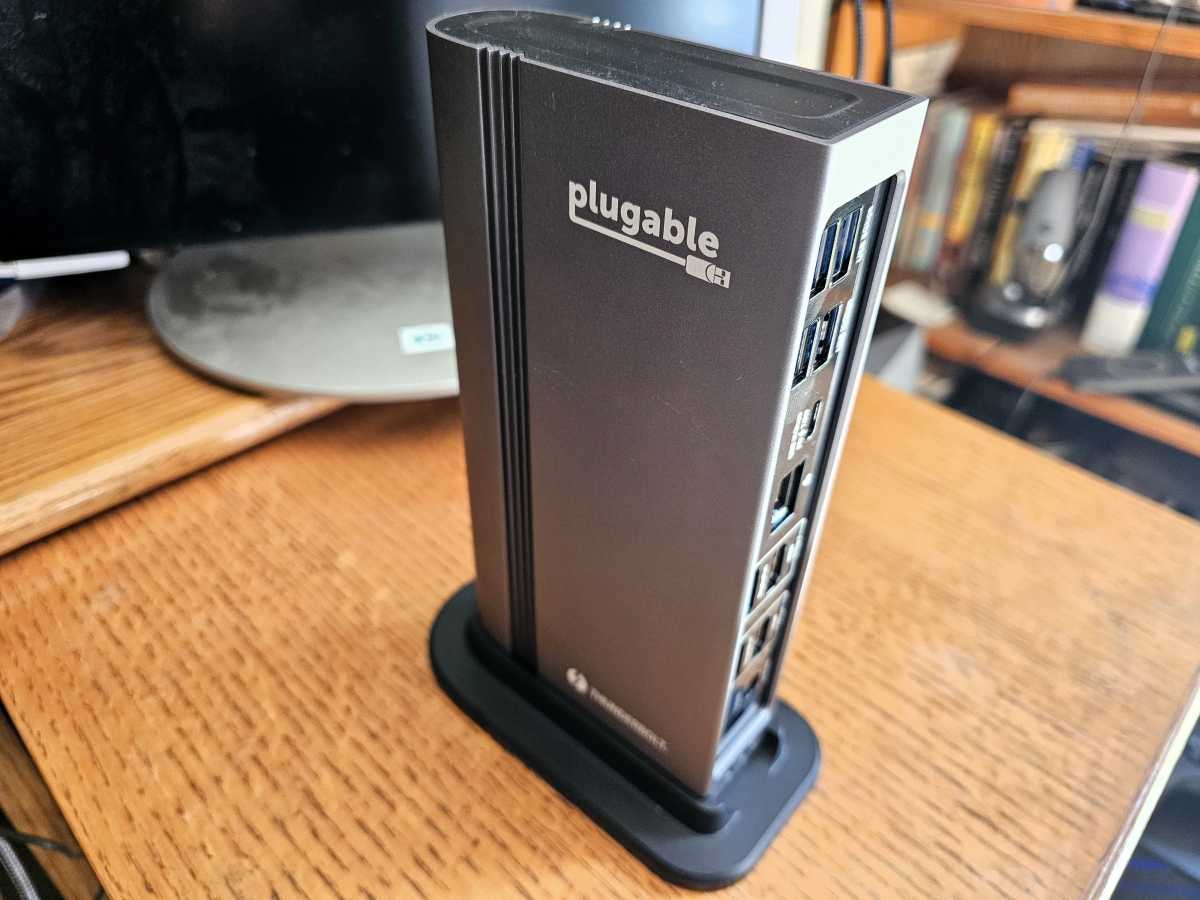
Mark Hachman / IDG
Laptops, smartphones, and other complex electronic devices contain varying numbers of components, many of them sourced from China — but also from Taiwan, Korea, Japan, Vietnam, and elsewhere in Asia. Some peripherals — especially peripherals like USB-C hubs, for example — ship directly to Amazon, produced by a variety of small Chinese startups. Intel manufactures its chips in countries like Israel, Ireland, and others, but packages them in still other countries, such as Malaysia. Tariffs are still assessed, whether on the individual components or the finished goods.
Other companies, such as peripherals maker Plugable, have moved their operations out of China. Plugable moved because of intellectual property concerns, but a variety of reasons have prompted manufacturers to distance themselves from China, IDC analyst Phil Solis wrote in an email. (IDC is owned by IDG, which owns PCWorld.)
“It is important to note that because of the tariffs introduced in President-elect Trump’s first term and kept in place by the Biden administration, the supply chain disruption from the global COVID-19 pandemic, countries looking to increase manufacturing jobs, and the potential for an escalation of the trade war, companies have already been shifting manufacturing to other countries such as Vietnam, Malaysia, India, and Brazil,” Solis wrote.
“The semiconductor ecosystem has seen chip fabs being built in countries around the world with government investments to help,” Solis added. “If tariffs were to focus only on China, the effects would be lessened overall by the fact that many companies have already shifted manufacturing to other countries from China or are planning to do so because of President-elect Trump’s statements about tariffs.”
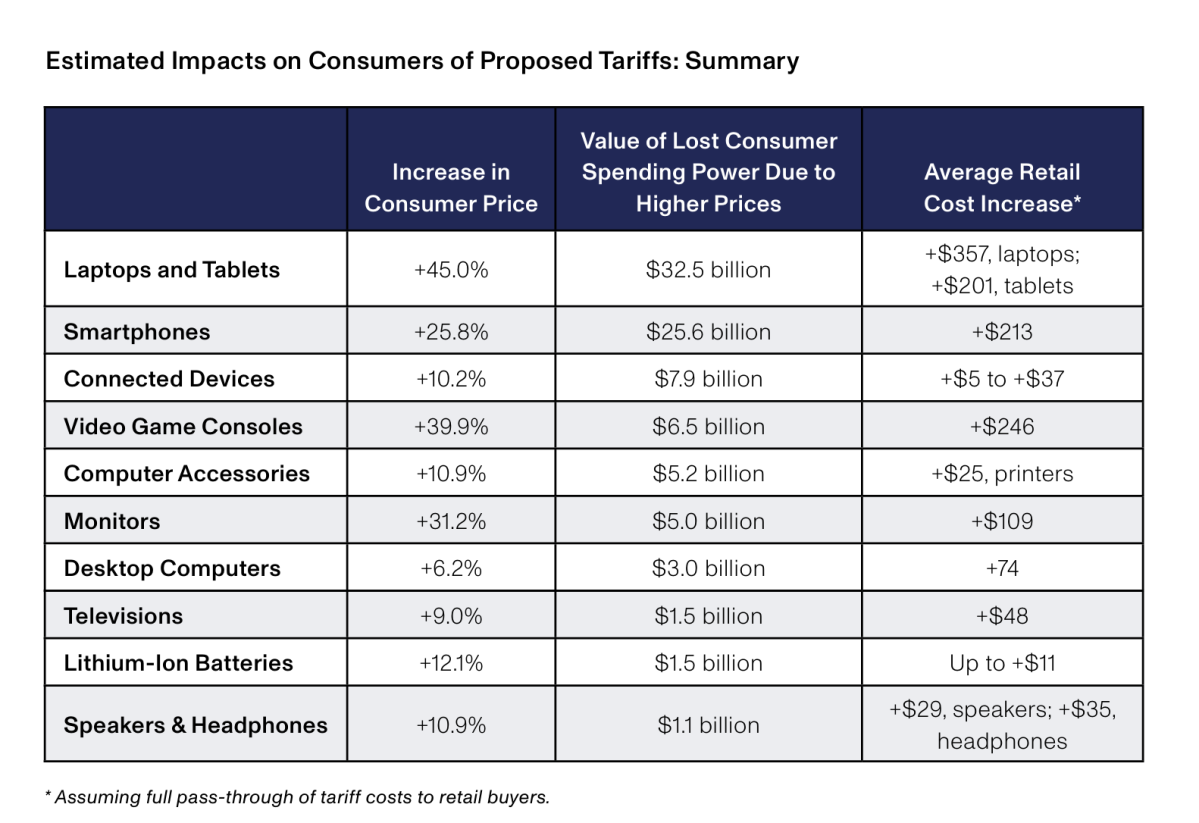
Consumer Technology Association
The CTA found that the current tariff on lithium-ion batteries — currently the highest the CTA tracked, at 5.9 percent — would go up to 50.5 percent under the new plan. Laptops and tablets would go from zero to 57.3 percent. Video games could be the hardest hit, with tariffs that would increase from zero to 62 percent.
That will raise prices across the board, the CTA estimated. The average laptop price will increase by $357. Oddly, the CTA was much more optimistic in terms of desktops, as prices might only increase by $74. Here, though, the tariffs would have their desired effect, as Chinese imports would essentially vanish. The price of computer monitors, many of which are imported from China, would increase by 31 percent or an average of $109.
Smartphone prices would increase by $213 (if a price of $816 is used as a baseline), the CTA found. Smartwatch prices would jump $37. Television prices might only go up $48 — but the cheapest TVs, such as those made by Chinese brands like TCL, might face relatively steep price increases. But it’s the price of video-game consoles that tech enthusiasts should worry about, with tariff costs potentially adding $246 to the total price.
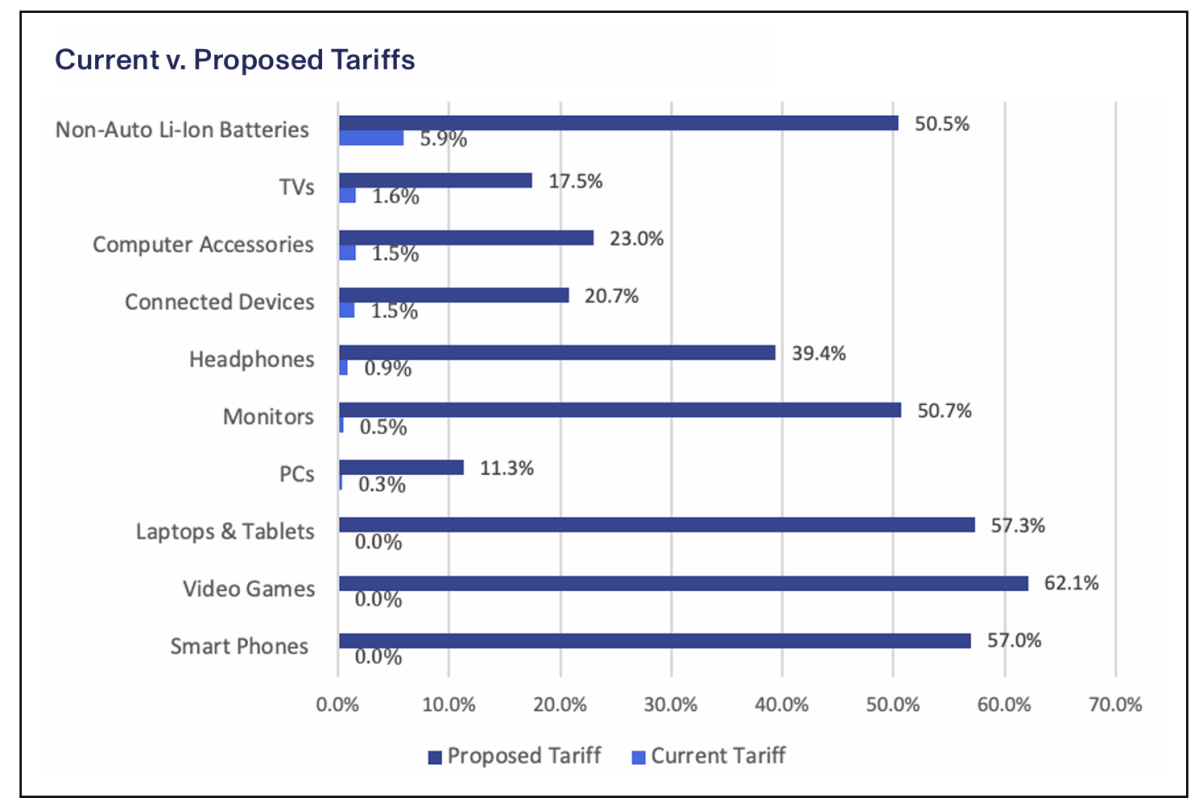
Consumer Technology Association
The NRF didn’t focus on consumer tech products, per se. Its examination of “household appliances” comes closest, with its estimates of prices for items like refrigerators, toasters, and ovens. Still, consumers are likely to pay between $126 to $202 more for a $650 refrigerator, the NRF found.
Can tariffs be avoided?
Yes, they can, if only because Trump is a negotiator. As Bloomberg noted, Apple chief executive Tim Cook essentially talked Apple out of the first Trump tariffs simply by flying to Trump’s New Jersey golf club and making his case. But that strategy has only seemed to work when individual company executives meet Trump one-on-one.
For now, tech companies haven’t had to answer the tough questions on how they plan to weather any Trump tariffs. Election Day (Nov. 5) fell shortly after major chipmakers like AMD, Intel, and Qualcomm reported earnings, which are accompanied by a routine grilling of executives by Wall Street analysts. Next up is Nvidia, which reports earnings on Nov. 20, followed by Dell on Nov. 26.
Meanwhile, contract manufacturer and iPhone builder Foxconn said Thursday, Nov. 14 that it’s diversifying its supply chain, and its chairman said that “it’s uncertain” what policies Trump will implement. Foxconn was the crown jewel of a 2017 plan to bring foreign manufacturing to the U.S., under Trump. It went bust.
Unfortunately, there’s no guarantee that corporations will keep prices down, even if they’re not subject to tariffs — one of the underlying issues of the Biden presidency.

Amazon, Apple
Snopes.com pointed out a 2020 economic paper that found that the price of clothes dryers rose by about 12 percent in 2012 and 2016, when the U.S. placed antidumping duties, or tariffs, on China and South Korea. The problem? Washing machines were the subject of the tariffs, not dryers. But dryer prices went up anyway. Preventing that is up to U.S. government agencies like the Federal Trade Commission…which may or may not face cuts by the new Department of Government Efficiency, or DOGE.
There are other corollary costs consumers could face: Proposed tariffs on cars imported from Mexico, and the phasing out of the federal tax credit for electric vehicles. Mario Morales, another IDC analyst, said he’s more concerned about the potential effects of the CHIPS Act, which hasn’t really paid out any substantial amounts of funding — and that Trump has promised to rework. What about immigration? That’s left even more uncertainty in the supply chain.
There’s even the very real possibility of a tariff war or trade war, where other countries place tariffs on American goods. U.S. exports then fall, hurting American companies. But it might not be China that imposes it, but Trump. In 2023, Trump suggested levying the exact same tariff other countries place on the U.S., as a retaliatory measure.
Basically, we don’t know for sure what will happen. That’s left some in the industry scratching their heads, wondering whether tariffs will turn out to be another Trump bluff, or the last opportunity to grab a bargain during Black Friday 2024 before prices jump hundreds of dollars next year. Is normalcy still a possibility? Analysts hope so.
“Hopefully cooler heads prevail over time,” IDC’s Morales said.
Author: Mark Hachman, Senior Editor, PCWorld

Mark has written for PCWorld for the last decade, with 30 years of experience covering technology. He has authored over 3,500 articles for PCWorld alone, covering PC microprocessors, peripherals, and Microsoft Windows, among other topics. Mark has written for publications including PC Magazine, Byte, eWEEK, Popular Science and Electronic Buyers’ News, where he shared a Jesse H. Neal Award for breaking news. He recently handed over a collection of several dozen Thunderbolt docks and USB-C hubs because his office simply has no more room.
Recent stories by Mark Hachman:
This is Amazon’s best Prime Day midrange Chromebook dealUp to 100 Lenovo laptops are a security risk—what now?






